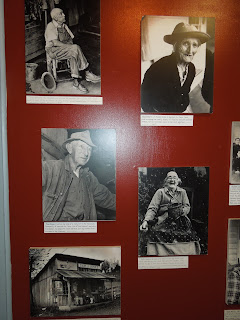Before I left in January, my Aunt Annette emailed about a couple of her favorite places to visit while in the south. The Museum of Appalachia in Norris was one of them and it was wonderful. It is now associated with the Smithsonian. We spent a good part of the day roaming the grounds and visiting the 35 buildings making up the museum.
 |
| Over 35 Buildings in a Gorgeous Setting |
These folks had be self sufficient, often times living ten miles or so from their nearest neighbor. They figured out what they needed and then figured out how to make it without using cash as they lived on the bartering system for the most part. The collection of handmade instruments and baskets were amazing. Whittling was an evening pass time and many pieces were really works of art. I don’t think many felt they could not be successful at what they attempted. This attitude allowed many to go out into the world to become doctors, politicians, war heroes, musicians, artists and more. Of course most stayed in the valleys, raised big families, went to church and worked hard day after day. Everything we have read in the museums we have visited talks about them being generally happy and contented with their life. The mission of the museum is to instill a greater knowledge of an appreciation of Appalachian history and heritage and it does that beautifully. The buildings are set out to resemble a farm community. Log cabins have been brought in along with a school, church, corn mill, saw mill, barns and outbuildings. The great part about it is that they were all furnished as they would have been, many with exactly what had been in them originally.
 |
| Church |
 |
| School |
 |
| Just need the teacher, books and kids. |
When we arrived there were five busses in the parking lot. School kids had inundated the place. Over 500 kids were here for a special demonstration day. They had music, sheep sheering, plus they had the saw mill going. We took it all in with them.
We had an appointment up the road for a tour at 1:00 of the TrailManor factory. We left the 500 kids and then return to an almost empty museum where we could take our time without any crowds. Both were great. I always love to see kids on field trips as long as I’m not connected to them in any way. We saw the Peters house where Cordelia was born and died at 87. Mark Twain’s family cabin was there. The family had moved from the cabin before he was born.
 |
| The Mark Twain Family Home |
In the early 1800’s, the Arwine family raised a large family in cabin and it has been designated as a historical place by the US Dept. of Interior. The plaque said it is the smallest home on the National Register of Historic Places.
 |
| The smallest house of the National Registry of Historic Places. |
 |
| A peek inside. |
 |
| This type of barn is only found in this area. The center is open with doors off the center to rooms on each side for tools and annimals. |
John Rice Irving is recovering from a stroke at 82 but still comes to the museum often. Hi daughter is following in his footsteps and is now President of the organization. They are still adding to museum. He is certainly meeting his goal of educating people from all over the world on the amazing resourceful people that lived in these southern Appalachian hills. Thanks for the heads up, Annette!
In the middle of all this, we went up to Jacksboro for our tour of the TrailManor factory. It is under new ownership and will hopefully take off again. It turns out we had met the new owner when we were in Portland buying the Manor in 2010. Bob was the regional sales manager then. When the company was thinking about closing their doors with the effects of the recession, Bob stepped up and bought it. I wish him well. It was pretty fascinating to see how the TrailManors are made using aircraft aluminum with a foam core making them so light weight. Eddy gave us a great tour and Norm was able to buy a couple of parts he needed for repairs. Pretty cool.
 |
| Chris and Norm talking with Eddy at the TrailManor factory. |
 |
| Chris standing in the "hallway to be." |
 |
| We ended our day back at the museum. |




No comments:
Post a Comment